9th GD Annual Meeting,
14th and 15th March 2005,
Veterinary University Vienna, Austria
Press Releases
![]() Burdened dermatological patients: additional expenses of up to 2.500 Euro per
year to be paid by the patient himself
Burdened dermatological patients: additional expenses of up to 2.500 Euro per
year to be paid by the patient himself
![]() Interdisciplinary focus on innovative dermatological therapy
treatment
Interdisciplinary focus on innovative dermatological therapy
treatment
![]() Neurodermatitis: improved treatment prospects by topical immunomodulators
Neurodermatitis: improved treatment prospects by topical immunomodulators
![]() Long-term control feasible for the first time at psoriasis
Long-term control feasible for the first time at psoriasis
![]() Ten-year progress for the well-being of skin
Ten-year progress for the well-being of skin
Press contact:
Dr. Joachim Kresken
Wiesengrund 6a
47918 Tönisvorst
Tel.: ++49 2162-6517
Fax: ++49 2162-80589
E-Mail: joachim.kresken@gd-online.de
Conversation partners at
the press conference were:
Prof. Dr. med. Werner Aberer, Graz (scientific conference head)
Prof. Dr. med. Thomas Luger, Muenster
Prof. Dr. Monika Schäfer-Korting, Berlin
Dr. Joachim Kresken, Viersen (GD president and pharmacist)
Burdened
dermatological patients: additional expenses of up to 2.500 Euro to be paid
by the patient himself
Gesellschaft für Dermopharmazie presents one-year data relating
to the consequences of the Health Service Reform
(Vienna, 14th March 2005) Following the Health Service Reform, effective since 1st January 2004, the supply situation of patients suffering from neurodermatitis, psoriasis, non-healing wounds and other chronic skin diseases has significantly aggravated. The patients have to bear the costs for a major part of the required therapeuticals themselves. According to first analyzes, the increase of self-payment amounts – according to type and severity of the disease – to up to 2.500 Euro per patient annually. The GD Gesellschaft für Dermopharmazie emphasizes these facts on the occasion of the opening of its 9th Annual Meeting in Vienna on 14th March 2005.
"Prime reason for this financial additional burden lies in the fact that the costs for proven basis therapeuticals for the treatment – such as for example urea preparations - are no longer paid by the public health insurance funds. However, also additional payments for rehabilitation services and ambulant treatments have considerably increased ", professor Dr. Matthias Augustin from the Dermatological University Clinic Hamburg-Eppendorf explains. For the first time current one-year data are presented at the GD Meeting which reflect a clear shift in the dermatological therapeuticals sector. While the overall turnover for therapeuticals of 20.2 billion in Germany increased again by 0.6 percent compared to last year’s results, it decreased in the same period for dermopharmaceutical products by 8.6 percent to 558.1 million Euros. Not even half of this amount, exactly 263 million Euros, was financed by the health funds – considerable 24.3 percent less than in the year before. The entire “balance“ had to be assumed by the patients themselves.
Extra costs of beyond 100 Euros per month to be borne by every sixth patient
The situation has significantly impaired owing to the legal reorganization in
such a way that prescription-free therapeuticals are no longer refunded by the
public health funds. Practically all dermatological diagnoses are affected by
this regulation, i. e. approximately 15 to 20 million people. This concerns
in particular a large number of persons suffering from a chronical dermatological
disease who are in permanent need of so-called basis therapeuticals: every sixth
patient suffering from psoriasis pays today the amount of 100 Euro and more
per month out of his own pocket, people affected by neurodermatitis bear average
costs of 94 Euro every month for their own treatment. These additional financial
expenditures have to be borne by persons concerned themselves without upper
limit because prescription-free therapeuticals may not be imputed to the maximum
limit of additional payments of one respectively two percent at chronical diseases.
„This is no longer affordable for many persons suffering from chronical
diseases“, professor Augustin expounds, „every fourth person concerned
is no longer able to financially procure the increased own contribution of treatment
costs.“
Patients delay or even abandon their therapy
Whether the actual objective of the Health Service Reform to decrease the costs
for the public health funds is achieved by means of these measures is in the
opinion of the GD Gesellschaft für Dermopharmazie absolutely questionable:
for due to the high financial burden many patients terminate their therapy or
defer the purchase of required new therapeuticals“. Professor Augustin:
"This attitude entails an aggravation of the clinical picture and consequently
higher costs of a further provision of many patients suffering from dermatological
diseases which is then in many cases stationary and to the debit of the public
health funds."
In view of the high financial burden many patients concerned are subjected
to for the treatment of dermatological diseases and the socially lopsided situation
connected with this regulation, the GD advocates a refunding of urgently required
basis therapeuticals by the public health funds. Important is furthermore to
develop novel, innovative drugs such as „Biologicals“ for psora.
„This first of all gives rise to further increasing costs“ professor
Augustin outlines. „Due to their particular effectiveness and increase
of quality of life connected therewith, they could however entail reduction
of consequential costs respectively alleviate the burden of disease on a long-term
basis.
Internationally renowned experts taking part in GD’s Annual Meeting
Approximately 250 participants from science and practice are expected to take
part in the two-day expert meeting taking place at the Veterinary Medicine University
Vienna (Veterinärplatz 1). "The scientific program is composed of
numerous high-ranking also internationally renowned experts from Germany, Austria,
Switzerland and even Taiwan”, the GD President Dr. Joachim Kresken points
out..
top
Interdisciplinary
focus on innovative dermatological therapy treatment
Dermatological
experts meet on the occasion of 9th Annual Meeting of the Gesellschaft für
Dermopharmazie in Vienna
(Vienna, 14th March 2005) The range of issues dealt with at 9th Annual Meeting of the GD Gesellschaft für Dermopharmazie in Vienna on 14th and 15 March reaches from research results originating from the sector development of active agents via measures of quality assurance to novel strategies for the treatment of chronical skin diseases such as neurodermatitis, psoriasis or the „open“ leg. Apart from numerous experts from the fields dermatology, pharmacy and cosmetics, the Austrian Minister for Health Maria Rauch-Kallat has also announced her participation in the first GD Meeting taking place in Austria. She will address a welcome on the occasion of the scientific main program on the second meeting day.
Mid-march the overall focus is directed at the largest human organ, the skin, at Veterinary Medicine University Vienna. „Primarily, of major interest are innovative therapy treatments for the abatement of chronical skin diseases“, professor Dr. Werner Aberer of Dermatological University Clinic Graz explains, He is – jointly with professor Dr. Claudia Valenta of the Institut für Pharmazeutische Technologie und Biopharmazie of Vienna University (Institute for Pharmaceutical Technology and Biopharmacy) responsible for the scientific conference organization. „Furthermore, current economic, health-political as well as cosmetic aspects are of particular significance in the diversified program of the meeting agenda, GD-president Dr. Joachim Kresken, Viersen, comments.
Chronical disease „open“ leg
Focal point of the meeting are non-healing abscesses of the lower leg, the so-called
„open“ leg. „Approximately one percent of the population is
affected by this chronical disease, mainly elderly women“, according to
professor Aberer. In many cases varices account for an „open“ leg.
If blood accumulates in the legs and the tissue is no longer sufficiently supplied
with oxygen and other nutrients, wounds only heal poorly. Apart from a genetical
disposition, overweight and a lack of exercise are considered to be major risk
factors. By means of an intensified therapy comprising above all compression-bandages
and –stockings it is possible to close such wounds permanently in the
majority of cases. This is good news primarily for younger patients. Modern
compression stockings are coloured, may even be in lurid colors and can be ideally
combined with usual clothing.
Innovative therapeuticalsa
Particular interest is directed to a novel medicinal therapy approach for neurodermatitis
and psoriasis. „By means of the so-called topical immunomodulators and
Biologicals, innovative, highly effective and at the same time safe therapeuticals
are available since quite recently”, professor Aberer affirms. Besides,
current results of research concerning not yet marketed novel active agents,
new fields of application for active ingredients which have been known for a
long time, innovative carrier systems for dermatological therapeuticals as well
as methods for an objective assessment of effectiveness for cosmetics are explained
and discussed.
Focus: Dermatological prescription
The dermatological prescription is equally comprehensively analyzed - both from a dermatological and a pharmaceutical view. „This term includes prescribing, preparing and dispensing of dermatological therapeuticals which are produced in a pharmacy“ the GD-president Dr. Kresken comments, who himself runs a public pharmacy. In various events, presence and future of the dermatological prescription in Germany, Austria and Switzerland are discussed; essential subject of discussion in this context is quality assurance. Dr. Kresken: „for this task the individual physicians and pharmacists bear responsibility just as chambers, expert societies and professional associations as well as producers and suppliers of prescription ingredients and packaging materials.“
Excessive financial burden for dermatological patients
A major focus is set on the topic Health Economy which is permanently subject to diversified discussion. This subject has been dealt with for the third time now on the occasion of an Annual Meeting of the GD. The society deplores that patients suffering from chronical dermatological diseases are excessively affected by the Health Service Reform due to the fact that they have to pay a large part of the necessary medicaments themselves at present. Whereas the legal health funds have achieved a decline of expenses for dermatological therapeuticals by almost 25 percent in the year 2004 compared to last year’s figures, the patients suffering from a chronical dermatological disease such as neurodermatitis or psoriasis have to pay up to several hundred Euro in the same period as additional charges. In the GD’s opinion, a high accessory financial burden of the kind represents a discrimination of chronical dermatological patients which is to be eliminated by the elaboration of revised legal regulations.
Neurodermatitis: improved treatment prospects by topical immunomodulators
Novel cortisone-free
active agents stop itching and eczema at an early stage
(Vienna, 14th March 2005) For a long time, cortisone-containing preparations were the first-choice remedy for the treatment of neurodermatitis. By means of the so-called topical immunomodulators Pimecrolimus and Tacrolimus, treatment alternatives are now available which are considered to be qualified products for long-term therapy and having fewer side effects. In contrast to cortisone products, they should already be applied at a very early stage of the disease in order to stop the emergence of eczema attacks. Professor Dr. Thomas Luger of University Dermatological Clinic Münster explained this fact at the GD Gesellschaft für Dermopharmazie’s 9th Annual Meeting proceeding in Vienna on 14th and 15th March 2005. A special symposium in the course of the meeting is dedicated to topical immunomodulators.
The itching skin rash is designated as neurodermatitis (also atopical eczema or atopical dermatitis). It may become a severe physical and psychical burden for all persons concerned. This dermatological disease is characterized by extreme dryness, scaliness, reddening and emergence of fissures. The disease which is due to a genetic disposition is triggered by exterior influence such as house dust mites, pollen or psychic stress already appears in many cases in the first months of life. It is characterized by acute scratch attacks in the course of which the persons concerned extremely rub their skin bloody. Neurodermatitis may develop at any age: in Germany or Austria approximately five percent of the population suffer from this disease, roughly half of the persons concerned are children.
Novel active agents Pimecrolimus and Tacrolimus
Regular skin care (basis therapy) by means of refattening creams, lotions, oil baths or similar preparations fulfils a double objective: first it counteracts dry skin and second it prevents new attacks of the disease. „If, however, the eczema can no longer be suppressed by means of the sole basis therapy, the new cortisone-free active agents Pimecrolimus or Tacrolimus should be applied in the first medicinal treatment stage “, professor Luger stresses. These novel substances allow an early intervention into the inflammatory process and thus a complete reversal of the treatment strategies in use so far. Originally, the treatment start had been retarded for a long time and the therapy commenced immediately with a cortisone-based preparation. Today, the so-called topical immunomodulators are already applied at appearance of first symptoms to stop the emergence of eczema attacks at first approach and prevent a chronical course of the disease.
Cortisone only for particularly severe cases
"Only at a further progressing pathology at the next stage, locally effective cortisone preparations should be applied“, professor Luger comments. „This however only until an improvement is achieved or a switch to the cortisone-free therapy with Pimecrolimus or Tacrolimus can be made“. If this treatment is not successful either, cortisone preparations active in the entire organism or therapeuticals suppressing the immune system are available at the last stage. Professor Luger: „This gradual concept will allow to significantly reduce the use of cortisone and to limit its application to the really severe cases."
Swift termination of inflammatory process
Cortisone preparations lead to a damage of the natural protective layer of the
skin and skin thinning (atrophy) as a consequence of longer external application.
At a prolonged application, cortisone is also able to penetrate the skin and
possibly cause growth and development disturbance after absorption into the
circulation. The novel topical immunomodulators in contrast are characterized
- apart from a temporarily appearing feel of burning after creaming - by a good
tolerance and they are also free of cortisone-typical side effects at long-term
application. They intervene immediately in cellular processes of the skin’s
immune system and stop the inflammatory process typical for neurodermatitis.
The effect sets in within a few days and entails a significant improvement of
symptoms for up to 90 percent of patients. Approximately half of the patients
are able to avoid the use of cortisone by applying Pimecrolimus and Tacrolimus
for at least six months. „Further studies are performed now directed at
establishing to which extent the early therapy with the novel active ingredients
influences the long-term course of the disease. Already today it is clear that
the new treatment methods have generated a lasting improvement of quality of
life of the patients concerned“, professor Luger concludes.
Long-term
control feasible for the first time at psoriasis
Novel therapeuticals for difficult-to-treat chronical skin disease
(Vienna, 14th March 2005) Psoriasis is one of the most straining skin diseases posing at the same time high requirements to treatment. Only in Germany and Austria far beyond two million people suffer from the so-called psoriasis. “Novel active agents directly intervening into the inflammatory process are subject to increased expectations”, professor Dr. Monika Schäfer-Korting from the Institut für Pharmazie (Institute for Pharmacy) of the Free University of Berlin explicates at 9th Annual Meeting of the GD Gesellschaft für Dermopharmazie which takes place in Vienna on 14th and 15th March 2005.
"By means of the so-called Biologicals of which first preparations have been recently approved we are able to control psoriasis at severely affected patients even over a long period“, professor Schäfer-Korting comments. So far acute disease episodes have been mainly treated with cortisone or therapeuticals suppressing the cleavage, above all of the immune system cells. After termination of the application of these substances, relapses can be frequently observed. The novel active agents, however, are conceived for a long-term treatment.
Novel therapeuticals terminate inflammatory process
Objective of the new therapeuticals which can be injected under the skin once or twice per week by the patient himself is to regulate the overactive immune system and to stop the inflammatory process. Biologicals directly intervene into the cell communication by blocking certain immune cells (T-lymphocytes) or second messengers (cytokines) which are in the beginning of the inflammation cascade and further the disease process. The active principle is very successful: various studies prove that psoriasis heals to over 75 percent at 39 to 70 percent of the patients. As unwanted effects troubles similar to influenza appear in particular after the first injection. However, also infections arise more frequently. „Owing to the presently unknown long-term effect, the therapeuticals are for the time being only prescribed to patients for whom usual treatment methods fail“, professor Schäfer-Korting outlines.
High-priced but cost-effective therapy
The costs accruing from the new therapy are remarkable in comparison to other treatment methods: the price for one injection according to active agent and packing size approximately amounts to 200 to 350 Euro. However, cost effectiveness does not equal cost minimization. In fact it represents a thorough balancing between costs generated and the benefit achieved for the patient. „Innovative therapeuticals such as Biologicals may – in spite of the high initial costs by all means be cost-effective if they contribute to an improvement of the quality of life of a patient and effect reduced consequential charges. The data necessary for an exact calculation of the cost-benefit relationship of Biologicals will have to be raised within the years to come“, professor Dr. Schäfer-Korting concludes.
Characteristical: accelerated cell regeneration
Following neurodermatitis Psoriasis (derived from Greek „psora“, scabies) is the most frequent chronical skin disease. The German designation Schuppenflechte refers to the typical acutely limited, red foci which are covered by silvery-white scurf (plaques) and partly considerably itching. Particularly affected are elbow, knee, scalp and back. The disease develops in attacks and may also seize joints, toe and fingernails. Symptomatical is the accelerated cell regeneration. In lieu of 28 days, the skin cells generated in the lowest epidermis layer migrate within three to four days to the skin surface. Owing to the fact that the cell development is incomplete in this short period of time, the consequences are large hornification disturbances as well as scale formation.
Triggering factors: infections and stress
The reason why this phenomenon comes about is not yet finally resolved. However, a genetical disposition is of major importance, 30 to 40 percent of the patients have near relatives suffering from the same disease. Risk factors responsible for the onset or aggravation are considered to be certain therapeuticals (for example drugs to combat rheumatism or cardiac diseases), infections (e. g. inflammations of the throat), climatic changes, but also personal living conditions such as stress, emotional strains, or increased consumption of alcohol.
Physically impaired, mentally afflicted
Psoriasis is not curable, however two thirds of patients experience at least transitionally longer disease-free episodes. The disease even disappears completely at every tenth patient with time. Until then it is a burdensome way to go because besides physical disturbance psoriasis represents a particular psychic burden. According to a recent investigation comprising 5,000 healthy participants, half of the persons investigated would neither kiss nor swim with a person affected in the same swim basin or take a meal prepared by a psoriasis patient. This is the case, although most people are aware of the fact that psoriasis is not a contagious disease. Professor Schäfer-Korting: „many patients affected feel stigmatized, have a high psychological strain and thus a considerably impaired quality of life.
Ten-year
progress for the well-being of skin
Commemorating ten years of Gesellschaft für Dermopharmazie in June
(Vienna, 14th March 2005) The GD Gesellschaft für Dermopharmazie e.V. will celebrate its decennial in a few weeks. Founded in the Deutsche Apothekerhaus (German Pharmacist House) in Eschborn on 20 June 1995, the GD has made it its task to further scientific research in all sectors of dermopharmacy, to introduce results from latest research and treatment methods not only to expert circles but also to a wide public as well as to foster intensive cooperation between physicians, pharmacists and other experts engaged in the field of dermopharmacy. Meanwhile, the society comprises roughly 300 members, among them almost all major experts from the German-speaking area.
Dermopharmacy itself is an interdisciplinary field at the interface of medicine and pharmacy. The GD deals with questions of external and internal application of therapeuticals, medicinal products, cosmetics and food additives which serve the prevention and treatment of skin diseases. The focus of its activities is set on efforts directed towards a dermopharmaceutical quality management reflected inter alia by organizing of consensus conferences as well as publishing of guidelines, standard procedures and other position papers. Concerning dermatological therapeuticals, the interest is both on ready-to-use pharmaceuticals and dermatological prescriptions prepared in pharmacies.
Comprehensive information material for experts and consumers
The guidelines published by the GD to date deal with dermocosmetics for the cleaning and care of dry skin and skin tending to acne, sun protection and occupational skin protection products as well as preparations of the dermatological prescription. The papers describe minimal requirements related to the quality of those products and address experts developing, producing, testing, analyzing, marketing the products or giving advice as to their application. Moreover, the GD participated in the elaboration of a guideline regarding actinic keratosis – a skin variance which is regarded to be a preliminary stage of the epithelioma, a special form of light skin cancer.
The numerous scientific statements published by the society so far likewise address experts. The last statement „Interdisciplinary Management of Tinea Pedis“ was published in September 2004. It contains proposals for the containment of the wide-spread disease mycosis pedis. The GD establishes guide brochures for consumers which are to date available for the subjects „Dry Skin“ and „Mycosis Pedis.“
Spreading of recent insights on conferences and via internet
The complete information materials of the GD are to be found on its internet homepage www.gd-online.de which has been extended to a Dermopharmacy Portal and can be downloaded free-of-charge. Recent scientific findings in the field of dermopharmacy are also published by its own dermopharmaceutical scientific journal „DermoTopics“ appearing twice a year as printed medium and online version.
Moreover, the GD organizes Annual Meetings and scientific symposia informing about recent trends from the most varying fields of dermopharmacy. Thus for example a symposium reflecting the present state-of-the art of research and official recognition of alternative methods for animal experiments took place in cooperation with the Free University and the Bundesinstitut für Risikobewertung (Federal Institute for Risk Assessment) in Berlin in November 2004 and received a high degree of attention. For this year, after 9th Annual Meeting of the GD in Vienna, a commemorative event of the society’s decennial in Mönchengladbach on 2 July as well as a symposium regarding the subject „Subcutaneous Cosmetics and their Alternatives: Benefit and Risk of Skin Augmentation“ in Berlin on 17 November are envisaged.
GD Press Conference Vienna 2005
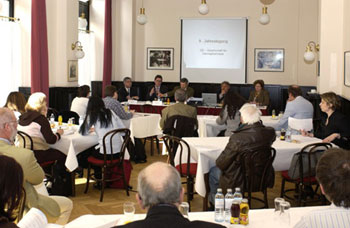
Photo: GD Gesellschaft für Dermopharmazie
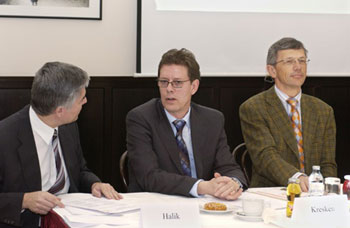
Photo: GD Gesellschaft für Dermopharmazie
Dr. Joachim Kresken, Viersen, (middle) in conversation with the
Moderator Dr. Claudius Halik, Vienna
Professor Dr. med. Werner Aberer, Graz (right).
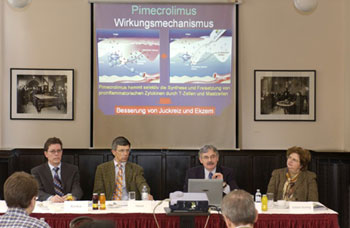
Photo: GD Gesellschaft für Dermopharmazie
From left: Dr. Joachim Kresken (Viersen),
Prof. Dr. med. Werner. Aberer (Graz),
Prof. Dr. med. Thomas Luger (Münster),
Prof. Dr. Monika Schäfer-Korting (Berlin).
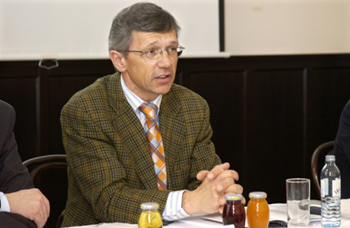
Photo: GD Gesellschaft für Dermopharmazie
Prof. Dr. med. Werner Aberer (Graz)

Photo: GD Gesellschaft für Dermopharmazie
Prof. Dr. med. Thomas Luger (Münster)
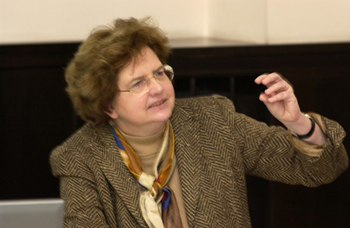
Photo: GD Gesellschaft für Dermopharmazie
Prof. Dr. Monika Schäfer-Korting (Berlin)
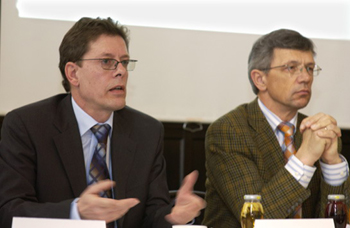
Photo: GD Gesellschaft für Dermopharmazie
Dr. Joachuim Kresken, Viersen, (links) und
Prof. Dr. med. Werner Aberer (Graz)
Copyright © 2000 - 2005 Institute for Dermopharmacy GmbH webmaster@gd-online.de